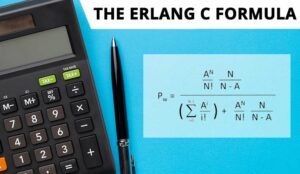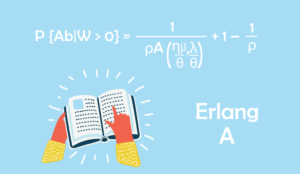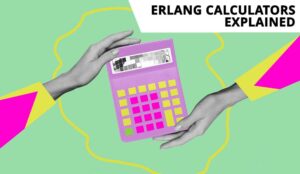Staffing a contact centre isn’t just about guessing how many people you’ll need on the phones. Get it wrong, and you risk long queues, stressed-out advisors, or wasted resources.
That’s why forecasters rely on tried-and-tested methods to get as accurate as possible, and to get you started, Call Centre Helper’s Jonty Pearce explains the Erlang C Formula.
Video: The Erlang C Formula
Watch the video below to hear Jonty explain the Erlang C Formula:
What Is Erlang C?
Erlang C is a mathematical formula that calculates the probability that a call will need to wait before being answered, and it plays a vital role in helping planners determine how many advisors are needed to meet service level targets.
Where Does Erlang C Come From?
The formula was developed over a century ago by Danish mathematician A.K. Erlang, a pioneer in the study of telecommunications.
“Erlang C is a formula that works out the probability that a call has to wait to be answered.
The formula was originally developed by the Danish mathematician AK Erlang, hence the name Erlang, over 100 years ago.”
Despite its age, Erlang C remains highly relevant today, particularly in environments like contact centres where inbound call volumes and wait times must be managed effectively.
What Does It Do?
At its core, Erlang C answers a key workforce planning question, as Jonty explains:
“It is particularly well suited to call centres as it allows you to work out the number of staff that you need for a given number of calls and a desired service level.”
It takes into account three main inputs:
- Call Volume – e.g., 100 calls per half hour
- Average Handling Time (AHT) – the average duration of the call, plus any wrap-up or after-call work (e.g., 300 seconds)
- Service Level Target – such as answering 80% of calls within 20 seconds
Based on these, Erlang C calculates the minimum number of advisors required to meet that service level, while recognising that some calls may still need to wait.
The Formula (Don’t Panic)
The actual Erlang C formula is quite complex and includes factorials and probability mathematics, not something most planners want to calculate by hand.
Thankfully, you don’t have to.
Use an Erlang Calculator
To simplify things, you can use a free Erlang Calculator, like the one available on the Call Centre Helper website, as Jonty continues:
“Luckily there is an easy way to do this and that is to use an Erlang Calculator. You can find one on the Call Centre Helper website. Just hit the Erlang tab.
You just enter in the number of calls – for example 100 calls per half hour.
You put in the average handling time (that is the talk time plus the time to process any post-call paperwork) for example 300 seconds, and a desired service level – in this case we use 80% of calls answered in 20 seconds.
So, in this case you will need 30 agents to handle these calls.”
Just enter the inputs mentioned above, and the calculator will do the work for you.
Example:
- 100 calls per half hour
- 300 seconds average handling time
- 80/20 service level target
You’ll need 30 advisors to meet demand in that time window.
Why It Matters
Using Erlang C helps prevent understaffing, which leads to long wait times, or overstaffing, which adds unnecessary costs.
It provides a structured, objective way to plan for contact centre performance, and when combined with real-world factors like shrinkage and occupancy, it’s a powerful tool for building reliable schedules.
If you are looking for more great insights from Jonty, check out these next:
- Is Overhang Distorting Your Staffing Calculations?
- Getting Started With Forecasting
- How Accurate is Your Forecasting?
- Maximum Occupancy – The Most Common Resource Planning Mistake
Author: Jonty Pearce
Reviewed by: Robyn Coppell
Published On: 15th Aug 2022 - Last modified: 12th Jun 2025
Read more about - Video, Editor's Picks, Erlang Calculations, Videos






































